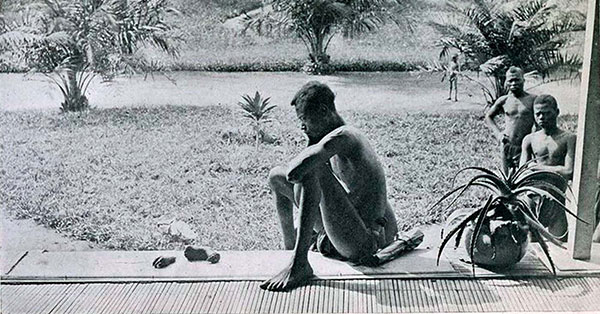A Congolese man stares at the severed hand and foot of his five-year-old daughter as punishment for failing to make the daily rubber quota, in Belgian Congo, 1904.
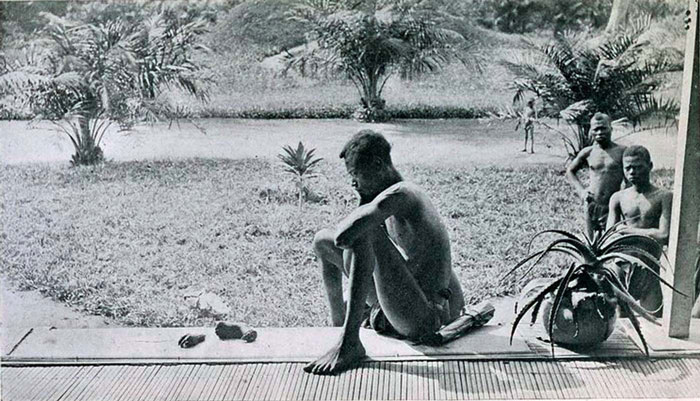
This photo was taken by Alice Seeley Harris. The man was identified as Nsala.
In her book “Don’t Call Me Lady: The Journey of Lady Alice Seeley Harris,” the author wrote:
“He hadn’t made his rubber quota for the day so the Belgian-appointed overseers had cut off his daughter’s hand and foot. Her name was Boali. She was five years old. Then they killed her. But they weren’t finished. Then they killed his wife too. And because that didn’t seem quite cruel enough, quite strong enough to make their case, they cannibalized both Boali and her mother. And they presented Nsala with the tokens, the leftovers from the once living body of his darling child whom he so loved. His life was destroyed. They had partially destroyed it anyway by forcing his servitude but this act finished it for him. All of this filth had occurred because one man, one man who lived thousands of miles across the sea, one man who couldn’t get rich enough, had decreed that this land was his and that these people should serve his own greed. Leopold had not given any thought to the idea that these African children, these men and women, were our fully human brothers, created equally by the same Hand that had created his own lineage of European Royalty.”
Founded and recognized by the Berlin Conference of 1885, the Congo Free State was a corporate state in Central Africa privately owned by King Leopold II of Belgium. In 23 years (1885-1908) of his reign in Congo, he massacred an estimated 10 million Africans by cutting off their hands, heads and even genitals, flogging them to death, starving them into forced labor, holding children for ransom, and burning villages. He committed such unimaginable atrocities without even setting foot in the Congo. Under King Leopold II’s administration, the Congo Free State became one of the infamous international scandals of the early 20th century.
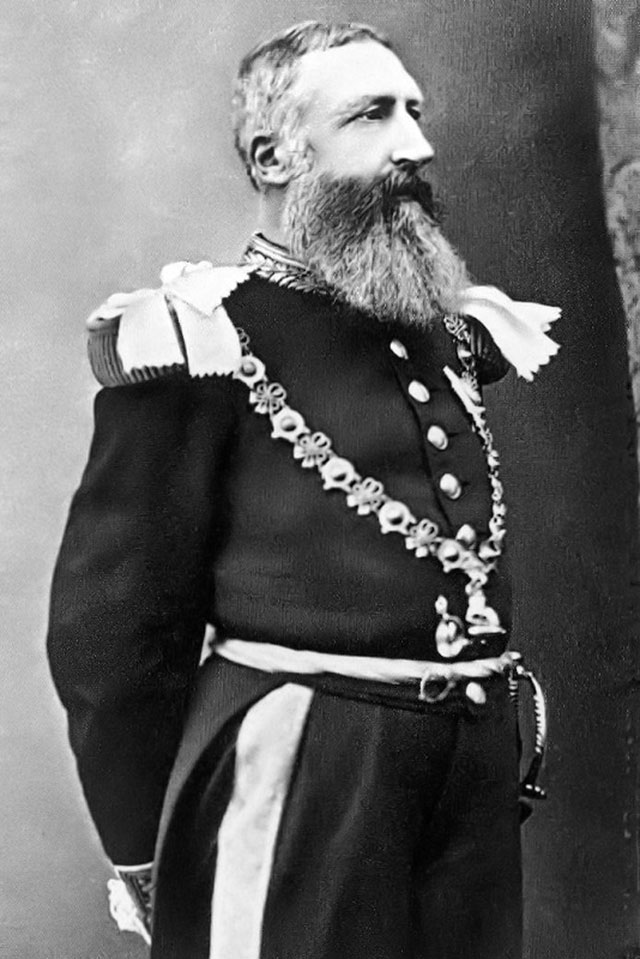
The ABIR Congo Company or the Anglo-Belgian India Rubber Company (later known as the Compagnie du Congo Belge) exploited the natural rubber found in the Congo Free State. The company enjoyed a boom through the late 1890s selling a kilogram of rubber in Europe for up to 10 fr that had only cost them 1.35 fr. This also came at a cost to the lives and human rights of those who couldn’t make the rubber quota or pay the tax with dismemberment, imprisonment, floggings and other brutal punishment ever recorded in human history.
Pictured below: British missionaries with men holding hands severed from victims Bolenge and Lingomo by ABIR militiamen, 1904.
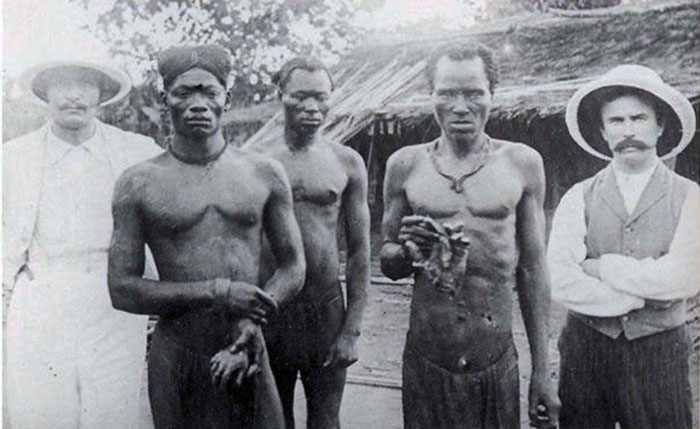
The punishment for any person who failed to meet the rubber collection quotas was death, enforced by the Force Publique (the gendarmerie/military force). The Force Publique were required to show the severed hand of their victims as proof that they had shot and killed them. It was believed that the officers would rather use their munitions for hunting. This resulted to more atrocities, in which the rubber quotas were in part paid off in chopped-off hands. Sometimes the soldiers would collect severed hands from villages for the Force Publique. As consequence, villages attacked neighboring villages to gather severed hands, as they failed to make the unrealistic rubber quotas.
A Catholic priest quoted a Congolese man named Tswambe who spoke of their hatred against the state official Léon Fiévez, who ran a district along the river 500 kilometers (300 miles) north of Stanley Pool:
All blacks saw this man as the devil of the Equator… From all the bodies killed in the field, you had to cut off the hands. He wanted to see the number of hands cut off by each soldier, who had to bring them in baskets… A village which refused to provide rubber would be completely swept clean. As a young man, I saw [Fiévez’s] soldier Molili, then guarding the village of Boyeka, take a net, put ten arrested natives in it, attach big stones to the net, and make it tumble into the river… Rubber causes these torments; that’s why we no longer want to hear its name spoken. Soldiers made young men kill or rape their own mothers and sisters.
A European officer described a raid to punish a village that had protested. He said that the European officer in command:
“…ordered us to cut off the heads of the men and hang them on the village palisades… and to hang the women and the children on the palisade in the form of a cross”.
After seeing a Congolese person killed for the first time, a Danish missionary wrote:
“The soldier said ‘Don’t take this to heart so much. They kill us if we don’t bring the rubber. The Commissioner has promised us if we have plenty of hands he will shorten our service”.
In Peter Forbath’s book The River Congo, he wrote:
“The baskets of severed hands, set down at the feet of the European post commanders, became the symbol of the Congo Free State…. The collection of hands became an end in itself. Force Publique soldiers brought them to the stations in place of rubber; they even went out to harvest them instead of rubber… They became a sort of currency. They came to be used to make up for shortfalls in rubber quotas, to replace… the people who were demanded for the forced labor gangs; and the Force Publique soldiers were paid their bonuses on the basis of how many hands they collected.”
King Leopold II of Belgium hired the mercenary force, Force Publique (FP), to do his terrorizing and killing. White Officers commanded black soldiers many of whom were cannibals from tribes in the upper Congo.
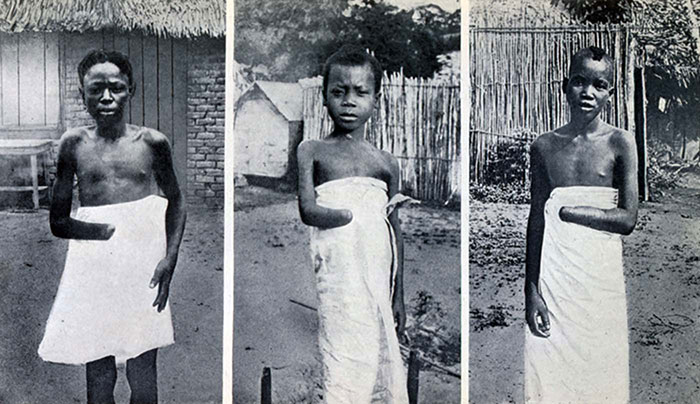
A few survivors later said that they had lived through a massacre by playing dead. They didn’t even move when their hands were chopped-off. They waited until the soldiers left them for dead before seeking help. If they wanted to, a soldier could shorten his military service term by bringing in more hands than the other soldiers, resulting to more terrifying widespread mutilations and dismemberment.
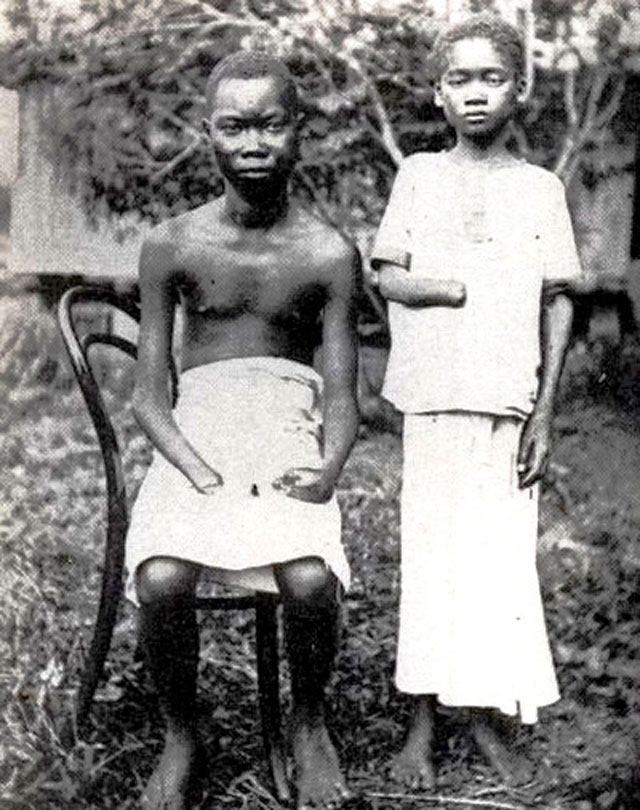
Estimates of the death toll under King Leopold II of Belgium reign vary considerably. But a reduction of the population of the Congo is noted by historians who have compared Congo before and the beginning of Belgian state rule in 1908. Contemporary observers said that the Congo population decreased by half during this period.

